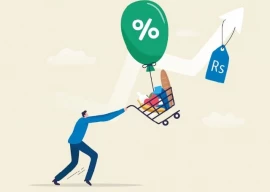
Total exports are down 13% compared to the corresponding period of last year. Major export items including textiles, rice, sports goods and cement have all shown downward movements both in terms of value and volumes.
Textile industry in its worst patch in history
The key concern has been the downward journey of textiles for the last two years. The textile sector, contributing nearly 60% to the exports of Pakistan, had a substantial competitive advantage in cotton-based textiles.
Pakistan is the world’s fourth largest producer and third largest consumer of cotton. The cotton industry from production of fibre to manufacturing of value-added products provides livelihood to 25 million people and contributes 10% to the gross domestic product.
Pakistan’s advantage in the textile industry lies in the lower segment of the value chain, predominantly the cotton spinning industry, where 500 units contribute 5% of the global spinning capacity. To fulfill raw material needs, the industry imports on an average one million bales of cotton mainly from India, the US and Central Asia.
Year 2015-16 will be tough for the industry due to the decline in cotton production both locally and globally. According to the industry forecast, global consumption will surpass production in 2016 due to a drop in the cotton plantation area by 6%. Pakistan will miss the production target by 5 million bales.
China has been one of the biggest buyers of Pakistan’s cotton yarn. In 2014, Pakistan exported cotton yarn worth $1.4 billion, 20% lower than exports in 2013. In 2015, the figure is also lower as Vietnam and India have been able to grab a substantial market share of Pakistan.
We represent the entire textile industry: APTMA
Tariff protection
In the domestic market, the spinning sector is also under pressure from cheaper imports from India. To protect the sector, the government had to take extraordinary measures by imposing a 10% regulatory duty on the import of cotton yarn and processed fabric. This increased the overall tariff protection to the industry to 15% as the regulatory duty was over and above 5% customs duty on imports.
Although the textile value-added sector was not in favour of the regulatory duty as it wanted cheaper inputs, especially yarn and fabric, the government had to come to the rescue of the spinning sector due to its substantial contribution to production and exports.
The textile industry is also suffering due to chronic energy shortages. The government had imposed a gas supply quota for the industry to meet 25% of its gas needs in winter and divert the rest to domestic consumers. This year has been particularly difficult as the quota has been reduced to 17%. This would further dampen the industry’s confidence, especially the value-added sector, and will increase the cost of doing business.
Impediments
The electricity shortages have also created sustainability issues for the industry. The magnitude of shortages has turned into a national energy crisis. At present, the country faces a demand and supply gap of 5,000 megawatts with demand growing in double digits annually.
The industry has to make arrangements for in-house power generation through imported furnace oil. This has impacted competitiveness and increased the transaction cost for production.
Textile sector: Identifying causes for low exports
Textile exports from Pakistan also face tariff barriers in markets of major trading partners. There has been a temporary relief for the industry in the European Union through tariff preference under the GSP Plus scheme.
The textile industry has also been complaining about sales tax refunds and duty drawbacks pending with the Federal Board of Revenue. According to industry sources, more than Rs100 billion in sales tax refunds are pending. The industry would obviously like to see expeditious clearance of all refunds so as to solve its liquidity problems.
Export-led growth model
The declining trend in exports, especially of the textile industry, should be a cause for concern for the policymakers as the country is pursuing an export-led economic growth model.
The major challenge is the energy shortages which may not be solved in the short term as most of the projects including the recently inaugurated Tapi project will not be online before 2018. In the short run, there may not be many options other than manipulating the exchange rate to promote exports. Most economists believe that the rupee is overvalued by 15% which is hurting exports.
There are compelling reasons for rescuing the textile industry through policy interventions. The rupee devaluation could be one of the viable options.
The writer is a development professional with over 20 years of experience in public and development sectors
Published in The Express Tribune, December 21st, 2015.
Like Business on Facebook, follow @TribuneBiz on Twitter to stay informed and join in the conversation.
1728297472-0/Fousey-(1)1728297472-0-405x300.webp)

1730806672-0/diddy-(37)1730806672-0-165x106.webp)
1731748155-0/BeFunky-collage-(8)1731748155-0-165x106.webp)













COMMENTS (1)
Comments are moderated and generally will be posted if they are on-topic and not abusive.
For more information, please see our Comments FAQ